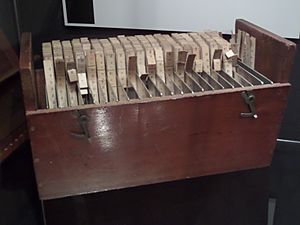Henry Lipson facts for kids
Quick facts for kids
Henry (Solomon) Lipson
|
|
|---|---|
| Born | 11 March 1910 |
| Died | 26 April 1991 (aged 81) |
| Nationality | British |
| Alma mater | |
| Known for |
|
| Scientific career | |
| Fields | Physics |
| Institutions |
|
| Influences |
|
Henry Lipson (born March 11, 1910, died April 26, 1991) was a famous British physicist. He became a Professor of Physics at the University of Manchester Institute of Science and Technology (UMIST). He worked there from 1954 to 1977. Later, he became a professor emeritus, meaning he kept his title after retiring.
Contents
Early Life and Education
Henry Lipson was born in Liverpool, England. His family had moved there from Poland. His father worked with steel. Henry's mother believed strongly in education. She made sure he went to Hawarden Grammar School.
At school, Henry won a special scholarship. This allowed him to study physics at Liverpool University. He finished his degree with top honors in 1930. After graduating, he stayed at Liverpool. He began doing research on how crystals are built. For this, he used a method called x-ray diffraction.
A Career in Crystal Research
Working with X-rays
Henry Lipson's main interest became studying crystal structures. He used x-ray diffraction to do this. He worked closely with another scientist named Arnold Beevers. They also got advice from Professor Lawrence Bragg. Bragg was a leading expert in crystallography in Manchester.
When they worked at Liverpool, Lipson and Beevers did not have much money. So, they often built their own equipment. They also invented a special tool to help with calculations. These tools were called Beevers-Lipson Strips. Before computers, these strips were very useful. They made Lipson and Beevers well-known in their field.
Moving to Cambridge
In 1936, Professor Bragg invited Lipson to move to Manchester. Lipson later followed Bragg to Teddington. Then, in 1937, Bragg became a professor at Cambridge. Lipson moved there too. In 1937, while in Teddington, he married Jenny Rosenthal.

At Cambridge, Lipson was in charge of the crystallography group. He played an important role in helping young scientists. While at Cambridge, he learned about the Fourier transform. He realized how important it was for X-ray crystallography.
Leading the Physics Department
Henry Lipson earned a DSc degree from Liverpool in 1939. He also got an MA from Cambridge in 1942. However, he did not feel fully at home in Cambridge. In 1945, he moved to the Manchester College of Technology. This college later became the University of Manchester Institute of Science and Technology (UMIST). He became the head of the physics department there.
At first, this job did not come with a special title. But under Lipson's leadership, the department quickly grew. It became a world-famous center for crystallography research. They pioneered new ways to study x-ray diffraction. These methods were based on the Fourier transform.
In 1954, he was made a full professor. In 1957, he became a Fellow of the Royal Society. This is a very high honor for scientists in the UK. He officially retired in 1977. However, he continued to be active in the department.
Beliefs and Recognition
Henry Lipson believed that scientists have a duty to society. He was an active member of Scientists against Nuclear Arms. This group worked against nuclear weapons. He was also president of the Manchester Literary and Philosophical Society twice. In 1976, he was awarded the CBE. This is a special award from the British government.
Later Life
Henry Lipson had three children: Ann, Stephen, and Judith. In 1991, the Lipsons were visiting their son in Haifa, Israel. Their son was a physics professor there. Henry Lipson had a heart attack and passed away on April 26, 1991.
Views on Evolution
Henry Lipson believed in something called "evolutionary creation." This means he thought that species have changed over time (evolved). However, he also believed that a creator was involved in this process. He wrote a paper called A Physicist Looks at Evolution.
Lipson did not agree with all parts of Darwinism. But he did not deny that species evolve. He once said that he did not see the Genesis story of creation as a scientific fact. He believed his idea of creation was more complex. He noted that his personal beliefs were not scientific because they could not be tested.

